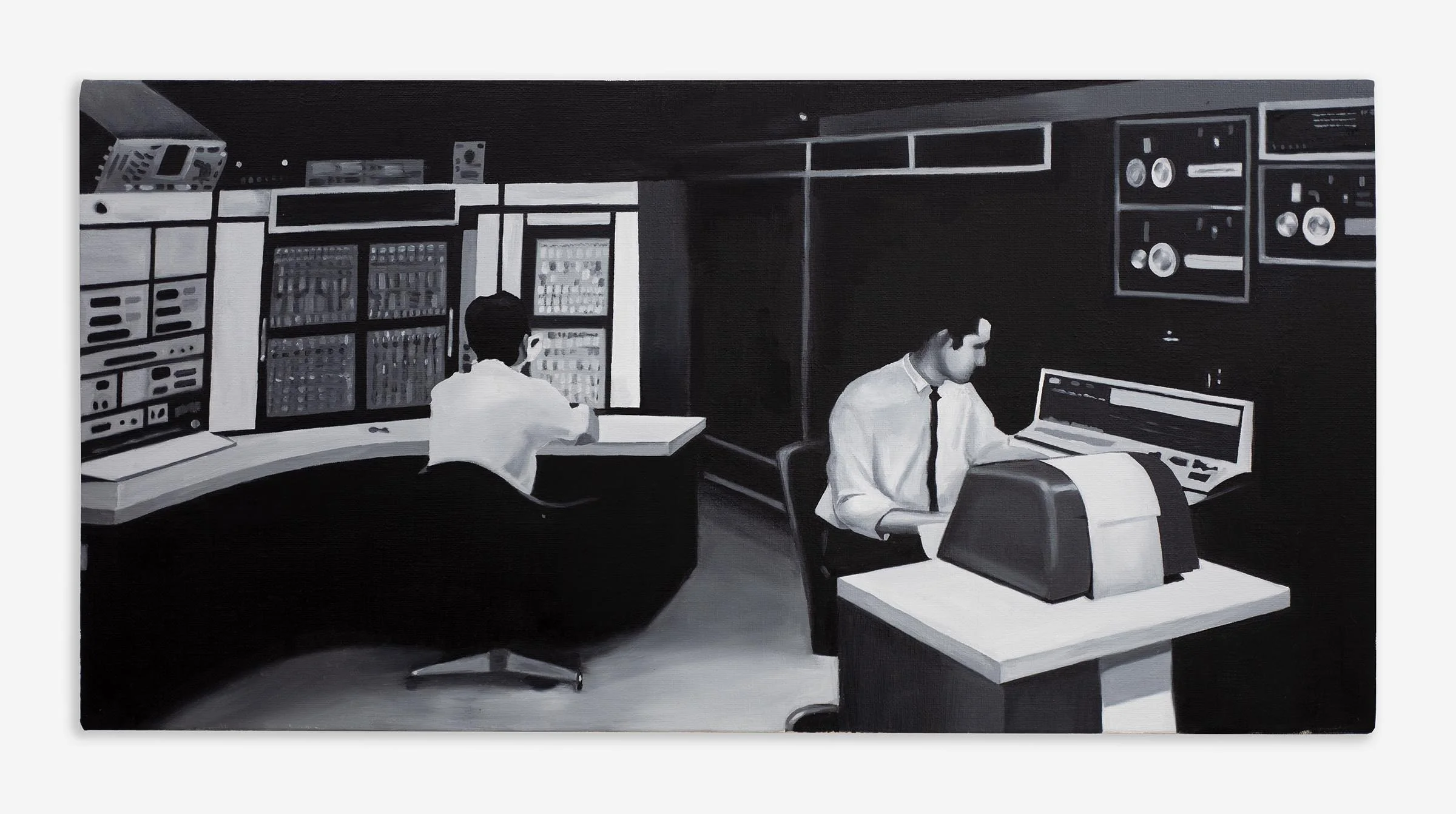Computing
Silicon, 2023
Oil on linen
76 x 91 cm (30 x 36 in)
The late 20th to early 21st centuries are often referred to as the Silicon Age, marking a period profoundly shaped by the element silicon's pivotal role in global development. Highly purified silicon, crucial for semiconductor electronics, forms the foundation of transistors and integrated circuit chips powering contemporary technologies like smartphones and computers. In the digital era, silicon's influence extends across various facets of daily life, influencing our work environments, entertainment choices, and modes of communication. Its pervasive presence underscores the transformative impact of silicon-based technologies on modern society's interconnected landscape.

Quantum Gaze, 2023
Oil on linen
244 x 193 cm (96 x 76 in)
The emergence of quantum computing is a herald of profound transformation within the contemporary technological panorama. Its significance surpasses the utilitarian, embodying a structural elegance that resonates with the intrinsic grace of the quantum realm itself. This intricate apparatus, orchestrated by the delicate choreography of superposition and entanglement, represents the zenith of scientific intricacy. Yet, within this tapestry of complexity, resides an unparalleled ability to model and compute with a finesse and rapidity that once dwelt beyond the realms of contemplation. As it addresses conundrums once deemed insurmountable, the quantum computer emerges as an engine of innovation, deftly navigating challenges ranging from the simulation of molecular interactions to the optimization of intricate logistical systems. In this painting, the demarcations between tangibility and abstraction are deliberately obscured, offering a reflection of the entwined essence of quantum particles. This amalgamation of realms, where boundaries intermingle, echoes not solely the labyrinthine dynamics of the quantum sphere, but also the enigmatic confluence of human essence and mechanical presence. Gazing upon this painting invites contemplation—an exploration of uncertainties inherent in an era that bears the imprints of artificial intelligence. Here, the fusion of human cognition and computational brilliance kindles both aspirations and uncertainties, forging a discourse on the trajectory that unfurls before us.
Silicon, 2021
Oil on linen
40.6 x 50.8 cm (16 x 20 in)
The late 20th to early 21st centuries are often referred to as the Silicon Age, marking a period profoundly shaped by the element silicon's pivotal role in global development. Highly purified silicon, crucial for semiconductor electronics, forms the foundation of transistors and integrated circuit chips powering contemporary technologies like smartphones and computers. In the digital era, silicon's influence extends across various facets of daily life, influencing our work environments, entertainment choices, and modes of communication. Its pervasive presence underscores the transformative impact of silicon-based technologies on modern society's interconnected landscape.

The Binary Dream, 2024
Oil on linen
76 x 46 cm (30 x 18 in)
"The Binary Dream, 2024" delves into the historical and symbolic significance of the IBM 704 electronic data processing machine in scientific research. Inspired by a photograph of a female NASA employee working with this pioneering computer, the artwork captures a pivotal moment in the evolution of technology and its applications in aeronautical research. The IBM 704, introduced in the 1950s, played a crucial role in early computational science with its ability to perform complex calculations at unprecedented speeds, becoming essential for NASA and other research institutions. The painting meticulously details the IBM 704, highlighting its intricate design and technological marvel, instrumental in advancing our understanding of aeronautics and space exploration, and laying the groundwork for future developments in computational technology.
"The Binary Dream" emphasizes the transformative impact of the IBM 704 on scientific progress, marking it as a precursor to the modern computing and artificial intelligence revolution. Its capacity for large-scale computations set the stage for the development of sophisticated computers and algorithms that form the backbone of today's AI technologies. The juxtaposition of the human figure with the imposing machine underscores the symbiotic relationship between human intellect and technological innovation. The artist's use of oil on linen lends a timeless quality, inviting viewers to reflect on the profound shifts in scientific methodologies brought about by such advancements. This artwork stands as a testament to the IBM 704's historical importance, celebrating its role in propelling humanity into a new era of discovery and exploration, ultimately leading to the digital age and the current AI revolution.

Checkmate, 2022
Oil on linen
91 x 76 cm (36 x 30 in)
The computer defeated the world champion Garry Kasparov. IBM’s Deep Blue computer stunned the world by becoming the first machine to beat Kasparov in a six-game match. Deep Blue's victory was a symbolic gesture to the rise of artificial intelligence—a triumph of machines over humankind. Fenghsiung Hsu initiated the Deep Blue project in 1985. In 1989, Hsu and other colleagues joined the IBM team to fully develop the machine. By the time of the 1997 match, Deep Blue's alpha-beta search algorithm and its custom hardware allowed it to consider up to 200 million positions per second. The painting Checkmate (2022) monumentalizes the machine as a significant milestone in artificial intelligence, highlighting its integration with strategic thinking and memory storage.

Logic Circuit, 2022
Oil on linen
76 x 76 cm (36 x 36 in)
Digital computers rely on the simple principle of manipulating on and off signals to implement logic functions. Mechanical devices, electromagnetic relays, vacuum tubes, transistors, and integrated circuits are among the many methods used in the past to generate these signals. In September 1960, Isy Haas and Lionel Kattner invented the first production version of the Micrologic “F” element flip-flop planar IC. Logic Circuit (2022) is a painted image of this circuit. The integrated circuits replaced transistors, allowing computers to be significantly smaller, an evolution that led to drastic increases in speed, cost efficiency, and everyday usage.

Quantum Computer, 2020
Oil on linen
46 x 61 cm (18 x 24 in)
IBM Unveils the World's First Commercial Quantum Computer Quantum computers could perform billions of times faster than current supercomputers Computation is the driving technological force behind many modern social and economic shifts. To better understand how computers will impact critical areas of our lives, we explore how they’re being used today and what forces will shape their future.

Mapping, 2021
Circuit board mounted on wood panel
64 x 50 cm (25 x 20 in)
A circuit board is the architecture of a computer’s mind at work. Its core function uses the same principle of manipulating on and off signals to prompt logical operations. It mechanically supports and connects electronic components to signal these happenings. Each hole and engraving on a chip has its meaning and serves its functions. In a collection of thirty-five found circuit boards, Mapping (2021) unfolds as an operation map spliced together. Arranged similarly to an astronomical pattern, the sculptural landscape resembles a night sky full of stars. Displacing the functional markings of a circuit board, together the engravings form random, abstract patterns. Pieced together, Mapping explores the practical nature of digitization while composing a visual representation of the universe in the midst of randomness and chance.



